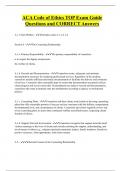Class notes
Lecture notes - digital transformation and strategic innovation
- Course
- Institution
Extensive lecture notes summary of the course digital transformation and strategic innovation, MSc Digital Business UvA. 52 pages and including visuals
[Show more]












